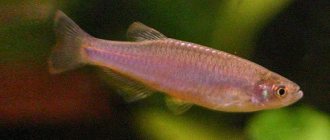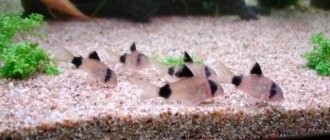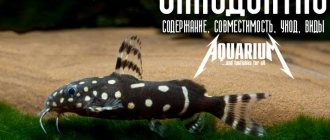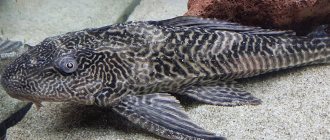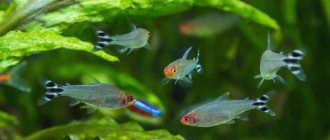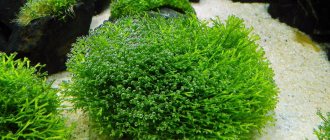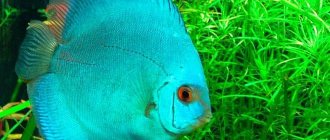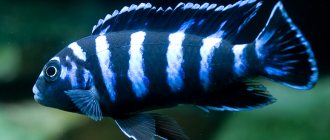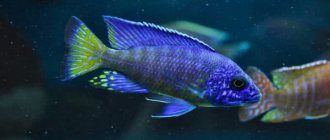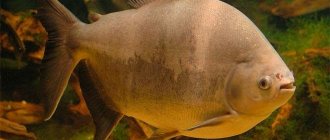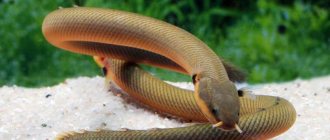Family\genus: cyprinid\danios.
Comfortable water temperature: 20-25 C.
Ph: 6,5–7,5.
Behavior: peaceful.
Compatibility of zebrafish: compatible with all peaceful fish.
Habitat and biotope: slow-flowing reservoirs of Southeast Asia.
Note that the eternal reclassification of fish, including the genus zebrafish, creates confusion among aquarists. In a nutshell - now the classification of all those who were previously called “zebrafish” is very confused. In fact, now only the former “rasboras” ( galaxy and erythromicron ) are included in the genus Danio, and even then only conditionally. All small species of zebrafish: rerio, leopard, pearl, pink, dotted, teenwini, khopra, kyatit (2 morphs), kerry, etc. - belongs to the genus Brachidanio. And the large species are Malabar, Sondhi, Dangila, etc. belongs to the genus Devario. But this classification is not final yet =) In fact, the genus Danio itself no longer exists. But who is classified as Brachydanio and who is Devario is not yet very firmly established =) Since classification by size is a conditional concept. These are the damn pies, friends!
Beautiful zebrafish
In this article, we will talk to you about the popular zebrafish. These fish often become the first pets for beginning aquarists. And for good reason! After all, these are bright, nimble, unpretentious babies that will decorate any aquarium.
Also, let's not forget about GloFish. That is, about genetically modified fluorescent fish . Zebrafish were the first fish to be modified. As a result, fish with red, green and orange fluorescent colors were obtained, which become brighter and more intense under blue or ultraviolet light.
But even without GloFish there are enough beautiful color morphs of zebrafish. There are a lot of them. The most popular are pink zebrafish, white zebrafish, gold, blue... grey-brown crimson.
But there is confusion here too. For example, “pink danios” are just a colored selection morph of the zebrafish ( Danio rerio var. rose ). The true Danio roseus are the danios now sold under the erroneous name "Danio Kerry".
And they, Danio roseus , must also be distinguished from pearl danios Danio albolineatus , which were also previously called “pink”. They are very similar to real pink ones.
The real Kerry zebrafish is:
These are the pies, friends, with these tributes!
Description of zebrafish
A small fish with a body length of up to 4.5 cm. The body is elongated, flattened laterally. Alternating blue and white stripes run along the body of the fish, starting from the gill covers and ending on the caudal fin. The caudal and anal fins are striped. The remaining fins are transparent and colorless.
Description and habitat
The optimal number of zebrafish in an aquarium is 5-7 pieces; you can keep a couple of individuals, but it is much more interesting to watch live school games of pets.
The body length of adult zebrafish found in nature is no more than 6-7 cm; in an aquarium they rarely grow more than 4 cm. There are inconspicuous antennae located next to the mouth. The back of healthy and young individuals is smooth and straight, the abdomen is oval. Females are easy to distinguish by their full bellies. Males are more graceful and noticeably longer. The body, tail and anal fin are decorated with bright yellow stripes. It is for this reason that the pet was nicknamed “zebra” in Europe, and “ladies’ stocking” by Russian aquarists.
Danios are constantly on the move, deftly maneuvering between plants, swimming in a school throughout the pond. Pets prefer the upper and middle parts of the aquarium. They rarely sink to the bottom.
If food or random insects fall on the surface of the water, the flock quickly rushes towards the prey. They are the first to grab dry daphnia and cyclops.
Photo gallery of zebrafish:
This behavior is also typical for the natural habitat. Zebrafish were first discovered by scientist Francis Buchanan Hamilton in small freshwater bodies of India. He also compiled a description of the fish. Their homeland is the tropical waters of Indonesia, Pakistan, Bangladesh, Nepal, Thailand and Burma. During river floods and the rainy season, zebrafish end up in stagnant bodies of water.
Fish feel equally good in running and standing water. Small flocks stay near the shore in the upper part. They catch small insects and crustaceans. Bright stripes and spots on the body act as protective coloring. As soon as a predator appears, a flock hides between the threads of aquatic plants.
Nutrition
Aquarium zebrafish are not too picky about the type of food they eat; in fact, they are omnivores. For such fish, food, both live, dry and frozen, is quite suitable, as long as it is suitable for their size. These can be insect larvae, small crustaceans, and worms.
Prey in the form of bloodworms and tubifex allows such creatures to frolic in pursuit of it, and therefore live food is usually recommended by experts more than others. A diet of dry food has a subtlety when used; it is advisable to thoroughly wet such a treat first, floating for a certain time on the surface.
Such pets should be treated daily. In this case, the entire volume can be fed at once or given in several doses, but in small portions, evenly distributing feedings throughout the day.
It is imperative to ensure that small waterfowl eat everything on time, that is, three minutes after the start of lunch or earlier. With one-time feeding, the period of food absorption can stretch up to five minutes. Based on the rate of food consumption, you can easily determine the norm that is reasonable to allocate to such wards.
These small aquarium creatures are big gluttons and gourmets, and therefore it is very important to ensure that they are not overfed. It should also be remembered that the way zebrafish looks .
Varieties of zebrafish
Through selection, aquarists have developed new varieties of these fish.
Veiled
Long transparent fins are the calling card of the veiled zebrafish. These species get along well with other harmless fish - neons, guppies, gouramis, mollies, platies, etc.
Leopard zebrafish
This is another species that owes its origin to breeders. Blue spots adorn the entire body of the individual. There is also a veiled subspecies of the leopard pet.
Glofish
The real pride of aquarists is the genetically modified subspecies of rerio Glofish. Individuals are obtained as a result of artificially implanted genes.
Glofish are capable of reproduction. Each subspecies has its own name: Red Fire Star, Green Electricity, Cosmic Blue, Purple Galaxy, Orange Sun.
The fluorescent jellyfish gene was used to create green luminous rerios. The red color is obtained as a result of the introduction of a coral gene. Initially, experimental pets were created for the purpose of monitoring the quality of the aquatic environment. When certain standards were exceeded, the fish began to glow.
Since 2011, purple and blue luminescent zebrafish have been released.
Breeders have created many subspecies of zebrafish with unusual colors - pearl, gold, diamond, coral, mother-of-pearl and others. All species are unpretentious, like their wild relatives, and are capable of breeding.
Reviews
My husband and I bought zebrafish about a year ago; they are very peaceful and cute fish. I think the disadvantage is that the fish are too mobile; Danios often jump out of the aquarium. I had to install the cover. Nina 42 years old, Samara
Danio rerio have been my favorite for 5 years now. There were no problems with care or reproduction. But after we added neighbors, the fish became almost invisible against the general background. Therefore, I think that these fish should be bought in large schools of about 10 individuals. Valeria 32 years old, Moscow
I have been breeding Danios for 14 years. These fish are completely unpretentious. Since I am a busy person, they suit me perfectly. The fish are small in size and very nimble. The aquarium was supplied with a lid immediately. Fish do not know when to eat in moderation, so you cannot overfeed them. My Danios get along well with laliuses, swordtails and platies. Igor 48 years old, Petropavlovsk-Kamchatsky
Care and maintenance in the aquarium
For keeping 6-8 adults. A rectangular aquarium of at least 60 liters is suitable. Danios love to swim, so a round one is unlikely to suit them. There must be free space in the middle and upper parts, not overgrown with plants.
Riccia, duckweed, vallisneria - fish find ciliates in them and hide from predators. Be sure to close the container with a lid, pets may jump out.
The water in the aquarium must be clean; zebrafish do not tolerate its flowering well. It is better to turn on the compressor at night and in the morning, since fish love oxygen, and at night there is always less of it. Additional heating is not needed if the temperature does not fall below +18 °C.
Conditions of detention:
- optimal temperature from +18 °C to +24 °C;
- acidity 7 pH;
- hardness 10-15 °dH.
How to distinguish a male from a female?
Sexual maturity of Danio Rerio occurs at the age of 3 to 6 months, so you should not delay in determining the sex of the fish.
First of all, females can be distinguished by their more convex abdomen. It is also worth considering that males are slightly smaller in size, but their behavior is much more active than the behavior of “girls”. The picture below shows an example of a male and female for comparison.
When populating an aquarium, it is important to maintain the correct ratio of the number of females and males , so you must understand how to distinguish a male from a female in order to fulfill this condition.
Male on top, female below. The main difference is that the female looks more rounded, her abdomen is visible, and the male is flatter.
Compatibility with other types
Pets are peaceful, do not offend anyone and get along easily with their neighbors. It is not recommended to keep rerio with heat-loving individuals - angelfish, gouramis, cockerels and mollies.
Good compatibility with goldens, neons, catfish, guppies, platies. It is better not to keep the veiled form with barbs, cichlids and swordtails; they can bite off pieces of their fins. As a result, the “lady's stocking” becomes lethargic, hides between plants, receives less food and can get sick and die.
Prevention
It is better to prevent any illness than to carry out medical procedures later. That is why new aquarium residents are kept in a separate container for 2-3 days in quarantine.
When purchasing specimens, their appearance is studied. If an individual humps, folding its fins, then this is a sign of weakened immunity.
We recommend that you study the appearance of zebrafish before purchasing
Moving to a new aquarium is stressful for aquatic life. Any aquarium fish is susceptible to temperature changes. A small jump of +/- 5°C can lead to the death of a migrant.
Important! A sick or suspicious fish is placed in a fish tank, where its current state of health is monitored.
To maintain a comfortable microflora for zebrafish and other aquatic inhabitants, the following preventive measures are followed:
- periodic air aeration;
- thorough filtration;
- regular water change;
- comfortable acidity level within the range of 6.5-7.5 pH;
- balanced and dosed feeding;
- sterilization of all important objects in the aquarium using boiling water or weak potassium permanganate.
Preparing the aquarium for stocking
If the conditions of general housing are violated, susceptible zebrafish can easily become ill; some ailments are easily curable, while others will require work to get rid of. Neglected diseases cannot be treated, which can lead to death. In order to prevent the spread of diseases, follow the necessary measures, and the nimble danios will delight the eye with their beautiful appearance.
Reproduction
These fish are ready to breed at 5-6 months.
Mating games and spawning in rerio are entertaining and beautiful. To prepare for spawning, zebrafish of different sexes are placed in separate containers. The fish are well fed with live food.
Readiness for spawning is determined by the female’s belly. The abdomen thickens, especially in front of the anus. For spawning, clean small containers (5-15 l) are prepared. Java moss is placed at the bottom of the spawning area, which is pressed down with a pebble. The water is clean, enriched with oxygen. Temperature does not play a special role, but for an additional stimulus it is recommended to gradually raise it by 2-3 degrees. The container is filled to a depth of only 5-8 cm. A free space of 3-4 cm remains between the substrate and the surface.
Spawning occurs early in the morning. 2-3 males are placed with one pregnant individual. Pets are released into the sanctuary in the evening. During the night they manage to adapt, and spawning occurs early in the morning. The fish rush around the aquarium one after another at high speed, the males try to catch up with the female. The mating dance is getting faster and faster, and then the zebrafish catch up with the pregnant woman and lightly hit her in the abdomen with their heads. The eggs sink to the bottom and the males fertilize them with milk.
Marriage catch-up resumes. After an hour, the spawning ends. At one time, the female lays from 50 to 100 eggs. After spawning, the rerio is transplanted into separate containers. After a week, the female is ready to mate again.
Sometimes spawning does not occur; the pregnant fish gets stuck in the moss and does not respond to males. If the belly is not round enough, it means that the pregnancy period is not over, and the female must be kept separately for a few more days.
The development of eggs depends on temperature:
- at +16 °C the caviar matures in 7-9 days;
- at +25…+28 °C the fry emerge on the second day.
Whitened eggs must be removed with a pipette. The hatched fry hang on the walls of the container until the yolk sac dissolves. As soon as the fry begin to swim, they are fed ciliates, Artemia nauplii and egg yolk. The water is constantly enriched with oxygen and filtered.
With plenty of feeding and proper housing conditions, the juveniles grow in 2-3 months. At low temperatures, development slows down.
Feeding
At home, fish are fed dry food, which is ground before serving. To diversify the diet of zebrafish, they are offered fruit flies and crushed bloodworms. Tubifex and brine shrimp are very useful.
Danios prefer to collect food on the surface and in the middle layers of water. The fish are fed in small portions: the remains will rot in the ground. Adult fish only need one meal; juveniles are fed twice a day. Once a week you can arrange a fasting day (only for adult fish).
Possible diseases
With proper care and maintenance, the “ladies' stocking” rarely gets sick. The first signs of illness are that a sick pet swims less and begins to stay away from the pack.
The fins are folded, the back bends, the fish appears stooped, the color fades, and with a prolonged illness, the stripes disappear and it becomes transparent. When parasites appear on the body, zebrafish begin to rub their abdomen on stones and grass. Some common diseases are listed below.
Bug-eyed
The disease develops due to increased acidity or excessive hardness of water.
Obesity
Occurs from overeating. This condition should not be allowed to occur in pets.
Trichodinosis
An infectious contagious disease caused by Trichodina ciliates. The pet begins to rub against stones and grass, and a dirty coating appears on the scales. The fish should be immediately placed in a separate jar and the temperature should gradually be raised to +30 °C. Use Tripaflovin or table salt as a medicine.
Alkalosis or alkaline disease
The cause of the disease is a shift in acid-base balance. The fish jump out of the water and scratch themselves on the rocks and plants.
Tuberculosis or mycobacteriosis
A dangerous infectious disease that is fatal. The causative agent is mycobacteria, which enter the aquarium from the external environment along with food, soil, and plants. Healthy fish become infected through sick ones. The individual becomes lethargic, eats poorly, stoops, and fins are destroyed. In severe stages, bulging eyes, bloating of the abdomen and loss of scales occur. Mycobacteriosis affects internal organs.
An accurate diagnosis can only be made by an experienced specialist through examination under a microscope. Sick pets are difficult to treat and more often die.
In the event of a mass exodus of fish, it was previously recommended to destroy all inhabitants (even snails and plants), replace the soil, and disinfect the aquarium and all equipment. Only very recently it became clear that mycobacteria do not manifest themselves when properly maintained.
Pets are affected by parasites when their immunity is weakened. Unfavorable water composition, toxic poisoning, stress, temperature fluctuations weaken the immune system.
Among the known drugs for the treatment of tuberculosis, Kanamycin is successfully used. Treatment is carried out in two ways:
- The medicine is added to water at the rate of 3-6 g per liter.
- Live food is soaked in the preparation and given to the fish. The duration of treatment is 12-14 days.
Price
The price of individuals varies depending on their species. So, for 1 pink zebrafish you will have to pay about 40-45 rubles. For leopard print – 50-60 rubles. For pearl or Malabar you will have to pay about 80 rubles. The most expensive are glofish and gold rings, costing 120-150 per piece.
Danio rerio is a popular and easy to care for aquarium fish. They are often started not only by beginners, but also by experienced aquarists. Due to the wide variety of species, everyone can find a pet to their liking.
Which zebrafish would you choose? Leave comments.
What types of Brachydanio rerio are there?
Due to the hardiness of zebrafish embryos, they are used as material in the field of genetic engineering. The result is the emergence of new forms of fish with different fins and body colors. The most famous breeding forms are “Glofish”, with veil fins and a leopard-like color. There are also other breeds.
Danio rerio with a mutant body color (Bleached blond) were obtained after manipulations by insertional mutagenesis. The hybrid form of the fish has lost its standard color with black pigment in melanocytes due to the inability to produce melanin. Wild Danio rerio in the first days of life (fry) have a dark body color, and hybrids of this form are born translucent.
Danio rerio Glofish are genetically modified fish whose bodies glow thanks to bioluminescence genes. The first hybrids appeared in 2003, and now they are found in many aquariums around the world. Thanks to the introduction of jellyfish DNA, the fish emit a glow. The forms of such fish with different shades of skin have been developed.
Danio kyathit (orange-finned) is a modified form of zebrafish, a model object for research. The color of the fins is yellowish, the edges have an orange edging. The fish is small, up to 5 cm in length. The body color is orange with horizontal blue stripes. The tail fin is translucent, with a blue shimmer.
General information
Danio glofish is an artificial form of the popular aquarium fish zebrafish (Danio rerio), the distinctive feature of which is fluorescence - the ability of cells of living organisms under certain conditions to emit photons of light, in other words, to glow.
To achieve a similar effect, scientists used the genes of marine coelenterates (corals and jellyfish), among which glow in the dark is widespread. Genes responsible for the synthesis of fluorescent proteins were introduced into the DNA of zebrafish, after which brightly colored fish appeared from the eggs, “flashing” under blue lamps.
Danio glofish can glow in certain lighting
It is worth noting that the glow of genetically modified glofish zebrafish has nothing to do with the coloring of fish and does not pose any threat to either humans or the aquatic inhabitants themselves. Moreover, the “glow” gene is inherited to subsequent generations. According to the conditions of keeping and feeding, the fish are absolutely no different from their natural counterparts.
How to dilute at home, instructions for beginners
Like fertilization, danio spawning is quite simple. Aquarists should only take care of the safety of the offspring, since adults immediately after spawning tend to eat most of the eggs . Let's look in more detail at how fish reproduce in an aquarium.
Where to breed?
Usually a separate aquarium is used as a spawning ground, since in general it is difficult to monitor the eggs, and subsequently the fry.
In a separate aquarium
For spawning, a separate aquarium is most often equipped, the volume of which is 20-40 liters.
An important condition is the presence of a special mesh, which is located at a distance of 2-3 cm from the bottom. It should fit tightly to the walls so that adult Danios cannot squeeze through to the eggs that have fallen to the bottom.
Some aquarists place special spawning soil, balls, tangled wires and other objects on the bottom that can hide the eggs from hungry parents.
Of course, the spawning area must be equipped with a compressor, a small filter, a heater and a lamp. If desired, you can place plants with long shoots (for example, elodea).
After placing all the necessary items, clean water is poured into the aquarium and left for several days. Thus, preparation of the spawning area must be carried out in advance.
In a common aquarium
An aquarium with a net is necessary so that the fry can hide behind it.
Sometimes spawning is carried out in a general aquarium if there are many different shelters and plants in it.
However, most of the eggs will still be eaten - if not by the Danios themselves, then by other inhabitants of the tank. With this method, you should not expect a large offspring, so it is still better to avoid spawning in a community aquarium .
Notes
- Life of animals. In 7 volumes/ch. ed. V. E. Sokolov. — 2nd ed., revised. - M.: Education, 1983. - T. 4: Lancelets. Cyclostomes. Cartilaginous fish. Bony fishes / ed. T. S. Rassa. — P. 250. — 575 p. : ill.
- N. F. Zolotnitsky (1851-1920) “Amateur Aquarium”
- Reshetnikov Yu. S., Kotlyar A. N., Rass T. S., Shatunovsky M. I.
Five-language dictionary of animal names. Fish. Latin, Russian, English, German, French. / under the general editorship of academician. V. E. Sokolova. - M.: Rus. lang., 1989. - P. 137. - 12,500 copies. — ISBN 5-200-00237-0. - Krotova N.A.
et al. Zebrafish as a new promising model in translational neurobiology // Russian Physiological Journal named after. I. M. Sechenov. — 2022. — Vol. 105(11). — P. 1417–1435. - (Russian) (undefined)
?. . Trinity option (February 17, 2018). Retrieved May 15, 2020.
- . minobrnauki.gov.ru. Retrieved May 16, 2022.
- (English). NASA (30 January 2015). Retrieved March 2, 2019.
- Dahm R.
The Zebrafish Exposed (English) // American Scientist (English) Russian. - Sigma Xi (English) Russian, 2006. - Vol. 94. - P. 446–453. - ↑
- Kristine Rainey.
. NASA (June 11, 2015). Retrieved February 8, 2022.
